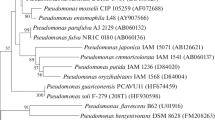Summary
A bacterium capable of growing on tetralin (1,2,3,4-tetrahydronaphthalene) as the sole source of carbon and energy has been isolated from soil of a coal dump. It has been identified as Pseudomonas stutzeri. The organism converts tetralin to 1-tetralol and 1-tetralone. The generation time is 50 h with tetralin, and 1.2 h with salicylate, respectively, as carbon source. Under conditions where the cells grow on tetralin the highest yield of 1-tetralol and 1-tetralone so far obtained is about 3% of the tetralin-input. The oxidation of an alicyclic ring structure by an arene-degrading bacterium is being discussed.
Similar content being viewed by others
References
Azoulay E, Heydeman MT (1963) Extraction and properties of alcohol dehydrogenase from Pseudomonas aeruginosa. Biochim Biophys Acta 73:1–6
Barnsley EA (1975) The induction of the enzymes of naphthalene metabolism in Pseudomonads by salicylate and 2-amino-benzoate. J Gen Microbiol 88:193–196
Chapman PJ (1979) Degradation mechanisms. In: Bourquin AW, Pritchard PH (eds) Microbial degradation of pollutants in marine environments. US Environmental Protection Agency, Gulf Breeze, USA, pp 28–66
Christova K, Dantschev D (1978) Derivatives of 2-amino-1,2,3,4-tetrahydronaphthalene. V: Synthesis of trans-2-amino-3,5,8-trihydroxy-1,2,3,4-tetrahydronaphthalene and N-substituted derivatives. Arch Pharmazie 311:948–953
Collin G (1979) Steinkohlenteer — Kohlenwasserstoffe. Zusammenhänge zwischen Eigenschaften und Verwendung. Erdöl und Kohle-Erdgas-Petrochemie 32:512–519
Dorn E, Hellwig M, Reineke W, Knackmuss H-J (1974) Isolation and characterization of a 3-chlorobenzoate degrading Pseudomonas. Arch Microbiol 99:61–70
Drozd JW (1980) Whole cell transformations. See ref. Harrison DEF, Higgins IJ, Watkinson R (eds), pp 75–83
Ganapathy K, Khanchandami KS, Bhattacharyya PK (1966) Microbiological transformations of terpenes. Part VII. Further studies on the mechanism of fungal oxygenation reaction with the aid of model substrates. Indian J Biochem 3:66–70
Harrison DEF, Higgins IJ, Watkinson R (eds) (1980) Hydrocarbons in Biotechnology. Verlag Heyden & Son, London, pp 201
Hopper DJ (1978) Microbial degradation of aromatic hydrocarbons. See ref. Watkinson RJ (ed), pp 85–112
Hosler P, Eltz RW (1969) Microbial conversion of p-xylene in stirred fermenters. In: Perlman D (ed) Fermentation advances, pp 789–805
Ivanov IC, Dantchev DK, Sulay PB (1978) Derivate des 2-Amino-1,2,3,4-tetrahydronaphthalins. IV. Synthese und Konfiguration der Diastereomeren 2,3,4a,5,10,10a-Hexahydro-4-naphth-[2,3,-b]-1,4-oxazine (“Naphthalanmorpholine”). Chem Ber 111:1164–1170
Jamison VW, Raymond RL, Hudson JO (1970) Hydrocarbon cooxidation by Nocardia corallina strain V-49. In: Amer Inst of Biol Sciences (ed). Developments in Industrial Microbiology, Garmond-Pridemark Press, Baltimore, pp 99–105
Jeffrey AM, Yeh HIC, Jerina DM, Patel TR, Davey JF, Gibson DT (1975) Initial reactions in the oxidation of naphthalene by Pseudomonas putida. Biochemistry 14:575–584
Ladd JN (1956) The oxidation of hydrocarbons by soil bacteria. I. Morphological and biochemical properties of a soil diphtheroid utilizing hydrocarbons. Aust J Biol Sci 9:92–104
McKenna EJ, Coon MJ (1970) Enzymatic ω-oxidation. IV. Purification and properties of the ω-hydroxylase of Pseudomonas oleovorans. J Biol Chem 245:3882–3889
Perry JJ (1979) Microbial cooxidations involving hydrocarbons. Microbiol Rev 43:59–72
Ratledge C (1978) Degradation of aliphatic hydrocarbons. See ref. Watkinson RJ (ed), pp 1–46
Schlegel HG (1974) Allgemeine Mikrobiologie. Thieme Verlag, Stuttgart, 3. Auflage, S 174
Shamsuzzaman KM, Barnsley EA (1974) The regulation of naphthalene oxygenase in Pseudomonads. J Gen Microbiol 83:165–170
Trudgill PW (1978) Microbial degradation of alicyclic hydrocarbons. See ref. Watkinson RJ (ed), pp 47–84
Tsuchii A, Suzuki T, Takahara Y (1977) Microbial degradation of styrene oligomer. Agric Biol Chem 41:2417–2421
Watkinson RJ (ed) (1978) Developments in biodegradation of hydrocarbons-I. Shell Research Ltd, Shell Biosciences Laboratory, Sittingbourne, Kent, p 232
Welch WM, Harbert ChA, Sarges R, Stratten WP, Weissman A (1977) Analgesic and tranquilizing activity of 5,8-disubstituted 1-tetralone mannich bases. J Med Chem 20:699–705
Author information
Authors and Affiliations
Rights and permissions
About this article
Cite this article
Schreiber, A.F., Winkler, U.K. Transformation of tetralin by whole cells of Pseudomonas stutzeri AS39. European J. Appl. Microbiol. Biotechnol. 18, 6–10 (1983). https://doi.org/10.1007/BF00508122
Received:
Issue Date:
DOI: https://doi.org/10.1007/BF00508122



